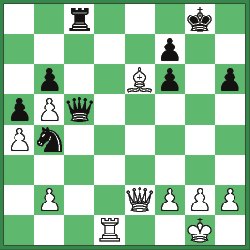|
Time
Out
Asian chess Chess
Chess
in Asia has a long history as the game actually originated
in this subcontinent and was developed by Arabs, and finally
given its modern form by Europeans. But Asians entered the
international chess scene rather late. Mir Sultan Khan was
the first Indian master to make his mark in the international
arena. He was recognised as a world class player but his chess
career was very short (1929-33). India had to wait for another
30 years to get its first International Master--Manual Aaron.
Other Asian nations were not really doing much better in the
1960's.
Eugene
Torre became the first Asian and Philipino grandmaster in
1974. Torre was considered to have the potential to challenge
Karpov. But he didn't live up to the expectations of his fans,
though he is still going strong and has made the Philippines
first board his private preserve. The appearance of the Chinese
players in international tournaments in the mid-seventies
was another important development. China has so far produced
many grandmasters and their national team has been performing
consistently in chess olympiads. Iran also had a strong team
in the seventies, but things went awfully wrong for the Iranian
players with the 1979 revolution. Today they have staged a
comeback and are doing well in international tournaments.
Emergence
of Niaz Murshed, the first grandmaster of this subcontinent,
was a sensational event. He won the coveted title in 1986
and that also pushed Asian chess a step forward.
But the
biggest breakthrough came when Viswanathan Anand began to
win tournament after tournament at the very top level of world
chess. He is by far the best player Asia has ever produced.
His successes also inspired other Indians to take up chess
professionally and opened the doors for private sponsorship
to flow in.
In fact,
even some Russian grandmasters believe India and China will
become the world leaders in chess by the year 2015! There
may be truth in it, since thousands of players are now participating
in hundreds of tournaments held in India every year. What
else do you need to produce another Anand?
White-
V Anand
Black-B Macieja [B17]
New Delhi 2000
1.e4 c6
2.d4 d5 3.Nc3 dxe4 4.Nxe4 Nd7 5.Bc4 Ngf6 6.Ng5 e6 7.Qe2 Nb6
8.Bb3 h6 9.N5f3 a5 10.a4 c5 11.Bf4 Bd6 12.Ne5 00 13.Ngf3 Nbd5
14.Bg3 Qc7 15.dxc5 Qxc5 16.00 b6 17.Rfd1 Ba6 18.c4 Rad8 19.Nd4!N
Bxe5 20.Bxe5 Nb4 21.Nb5 Bxb5 22.cxb5!? Rxd1+ 23.Rxd1 Rc8?
24.Bxf6 gxf6 25.Bxe6!+- fxe6 26.Qxe6+ Kh8 27.Qxf6+ Kg8 28.Qe6+
Kh8 29.Qxh6+ Kg8 30.Qe6+ Kh8 31.h3 Rf8 32.Qh6+ Kg8 33.Qg6+
Kh8 34.Qg3! Qc2? 35.Rd4 1-0

Position
after 25.Be6!
-PATZER
Copyright
(R) thedailystar.net 2005
| 